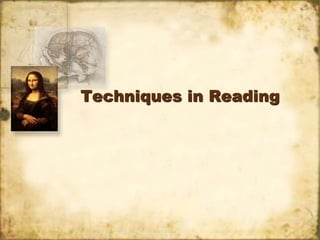
Techniques in reading.ppt
- 2. Skimming – selective reading of material • Preview if the material contains the information needed • Overview – the purpose & scope of the material • Survey – the general idea contained in the material
- 3. Scanning – a quick search for a specific information • Keep in mind only the specific information to be located • Decide which clues will help to find the required information • Move eyes as quickly as possible down the page to find the clue • Read the section containing the clues to get the needed information
- 4. • Skimming and scanning are very rapid reading methods in which you glance at a passage to find specific information. These reading methods make it easier for you to grasp large amounts of material, especially when you're previewing. They are also useful when you don't need to know every word. Skimming and scanning are especially valuable when there is only one item of information that you need to find from a particular passage.
- 5. 1. Read the title. 2. Read the introduction or the first paragraph. 3. Read the first sentence of every other paragraph. 4. Notice any pictures, charts, or graphs. * Notice any italicized or boldface words or phrases. 5. Read the summary or last paragraph. Skimming refers to the process of reading only main ideas within a passage to get an overall impression of the content of a reading selection. An example of this is when we read the title of a newspaper to know what happens everyday. How to skim:
- 6. 1. State the specific information you are looking for. 2. Try to anticipate how the answer will appear and what clues you might use to help you locate the answer. For example, if you were looking for a certain date, you would quickly read the paragraph looking only for numbers. 3. Use headings and any other aids that will help you identify which sections might contain the information you are looking for. 4. Selectively read and skip through sections of the passage. Scanning is a reading technique to be used when you want to find specific information quickly. In scanning you have a question in your mind and you read a passage only to find the answer, ignoring unrelated information. How to scan:
- 7. SQ3R • Survey – skim the material for its content & organization • Question – check the section headings & ask questions to set you purposes for reading • Read – read to answer questions that were earlier formulated • Recite – answer the questions without referring back to the material • Review – check how well you remember the major ideas
- 8. Comprehensive reading – slow & careful reading to extract information & understand a material containing a great deal of information 1. Vocabulary recognition 2. Sentence comprehension a. sentence analysis b. recognizing punctuation clues c. recognizing reference terms d. recognizing signal words - addition: and, as well as, besides - cause-effect: hence, due to, as a result - condition: if, when, unless
- 9. - contrast: but, though, despite - comparison: like, unlike, in the same way - emphasis: above all, really, in effect - sequence: first, later, eventually - examples: for example, that is 3. Paragraph analysis 4. Interpreting illustrations
- 10. Critical reading • Examine the reliability of the material • Distinguish facts from opinions • Draw inferences from the material
- 11. UNDERSTANDING PASSAGES A. Noting Details – a factual type of reading comprehension in which the reader is directly concerned with remembering the items within the passage • Be definite about your purpose in reading a selection. • Read the passage slowly and carefully. • Remember the details in relation to ideas you want to remember • Distinguish main or big ideas from sub ideas
- 12. B. Getting the Main Idea – finding the most important thing an author is trying to say • Find out what common ideas the sentences share • The presentational style may provide clues in finding the main idea • The main idea is the important information about the topic • A topic sentence may or may not contain the main idea • See to it that the main idea statement is not so general that it suggests information that is not given in the paragraph
- 13. Inferring – mentally exploring then taking a position in relation to the facts & related details Making Generalizations – relating the important elements within a passage in order to combine them into a principle, a generalization, or a conclusion • Know what topic is being discussed • Take note of the facts presented whether implied or directly stated • Find out how the sentences are related to one another in content • State a general idea that will include all the sub-ideas expressed in each sentence
- 14. Predicting Outcomes – identifying the relationships between the given facts in order to identify an expected outcome or a probable consequence based on certain tendencies or trends observed • Examine the available data and their relationships • Make conclusions or generalizations about the topics presented • Anticipate a possible outcome based on the material read